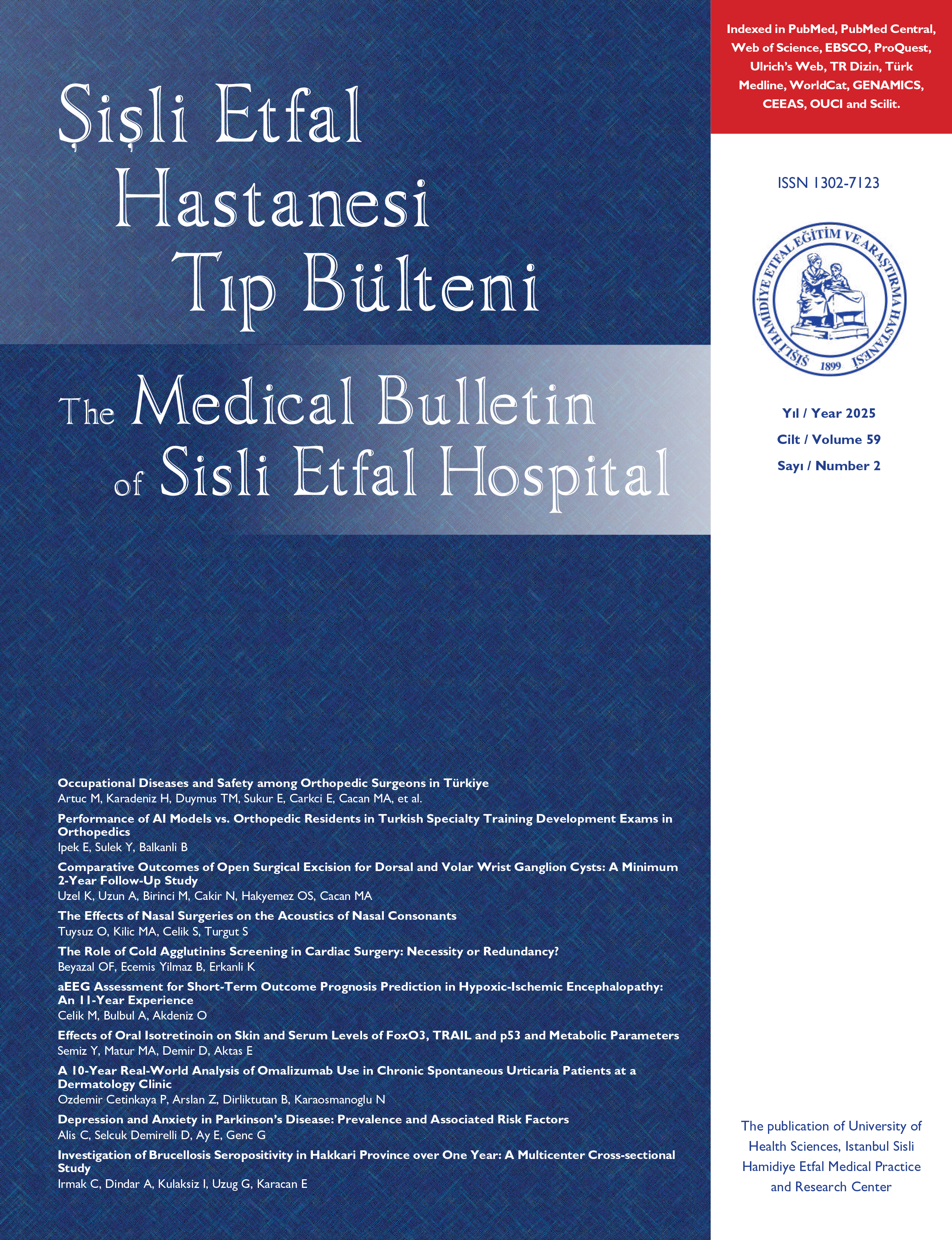
Üçlü tarama testi sonuçları kötü gebelik sonuçlarını öngörür mü?
Hale Göksever Çelik, Engin Çelik, Gökhan YıldırımKanuni Sultan Süleyman Eğitim ve Araştırma Hastanesi, Kadın Hastalıkları ve Doğum Kliniği, İstanbul - TürkiyeAmaç: İkinci trimestır maternal tarama testlerinden üçlü tarama testi özellikle Down Sendromu olmak üzere bazı fetal kromozomal anormalliklerinin riskini tayin etmek için kullanılır. Bunun yanında pek çok kötü gebelik sonuçları da bu testle öngörülebilmektedir. Çalışmamızda kötü gebelik sonuçları ile üçlü tarama testi sonuçları arasındaki ilişkiyi tespit etmek ve bu kötü obstetrik sonuçlar için serum belirteçlerinde kesim noktası değerleri tanımlamayı amaçladık.
Gereç ve Yöntemler: Nisan 2014 ve 2015 tarihleri arasında bir yıllık sürede üçlü tarama testini hastanemizde yaptırmış ve doğum yapmış 1372 gebe kadın çalışmaya dahil edildi. Yaş, kilo, obstetrik öykü, komorbid durumların varlığı, yardımcı üreme tekniği kullanımı, sigara içme, üçlü tarama testi ve doğumdaki gestasyonel hafta, doğum şeklini içeren hastaların tüm demografik ve klinik özellikleri
kayıtlardan elde edildi.
Bulgular: Populasyonun ortalama yaşı 27.9±5.6 olup ortanca yaş 28 idi. Üçlü tarama testinin yapıldığı gebelik haftası ortalama 17.3±1.0 iken doğumun gerçekleştiği hafta ortalama 38.3±2.7 idi. Çoğu hasta multipar olup vajinal yolla doğum gerçekleşmişti. Kötü gebelik sonuçlarına çoğunlukla daha ileri yaş multipar hastalarda ve sezaryen olmuş grupta rastlanıldı. Kötü gebelik sonuçlarına yönelik kesim noktaları AFP için > 0.935 MoM, E3 için < 0.945 MoM, hCG için > 0.945 MoM olarak tespit edildi.
Sonuçlar: Düşük maliyeti ve kromozomal anormallikleri öngörmede yüksek etkinliğe sahip olduğu için ikinci trimestır tarama testi kliniğimizde tüm hastalara uygulanmaktadır. Aslında birinci trimestır tarama testi ile kötü gebelik sonuçlarının öngörülmesi yatak istirahati, aspirin kullanımı gibi önleyici yaklaşımların uygulanabilirliği nedeniyle daha anlamlıdır. Yine de hastaları ikinci trimestır tarama testinin kötü gebelik sonuçlarını öngörmedeki faydası konusunda bilgilendirmek ve yapılmasını önermek önemlidir
Do triple test results predict the risks for adverse pregnancy outcomes?
Hale Göksever Çelik, Engin Çelik, Gökhan YıldırımKanuni Sultan Süleyman Eğitim ve Araştırma Hastanesi, Kadın Hastalıkları ve Doğum Kliniği, İstanbul - TürkiyeObjective: Of the second trimester maternal screening tests, the triple screening test, is used to determine the risk of certain fetal chromosomal abnormalities, particularly Downs Syndrome. Besides the risk assessment for chromosomal abnormalities, many adverse pregnancy outcomes (APO) can be predicted with this test. In our study, we aimed to determine the relationship between the triple screening test results with APO and to define the cut-off values in serum markers for these APO.
Material and Methods: A total of 1372 pregnant women who had a triple screening test between April 2014 and 2015 and then gave birth in our hospital during the period of one year were included in the study. Complete demographic and clinical characteristics were obtained from records including age, weight, obstetric history, presence of any comorbid conditions, in vitro fertilization pregnancies, smoking, gestational weeks on triple screening test and at delivery, birth weight, type of delivery, gender of baby.
Results: The mean age of our study population was 27.9±5.6, whereas the median age was 28 years. The mean gestational week was 17.3±1.0 during the triple screening test, and 38.3±2.7 at the time of delivery. Most patients were multiparous and had vaginal delivery. The APO were encountered mostly in the older age multiparous patients and in cesarean group. The cut-off values for APO were determined to be > 0.935 MoM for AFP, < 0.945 MoM for E3 and > 0.945 MoM for hCG.
Conclusions: The second trimester screening test is applied to all patients in our clinic, due to its low cost and high effectiveness in predicting the chromosomal abnormalities. In fact, determination of risk for the APO with the first trimester screening test is more meaningful, because of the feasibility of prevention strategies such as bed rest and use of aspirin. Nevertheless, it is important to inform the patients about the benefits of the second trimester screening test to be predicting APO and recommend it.
Makale Dili: Türkçe



















